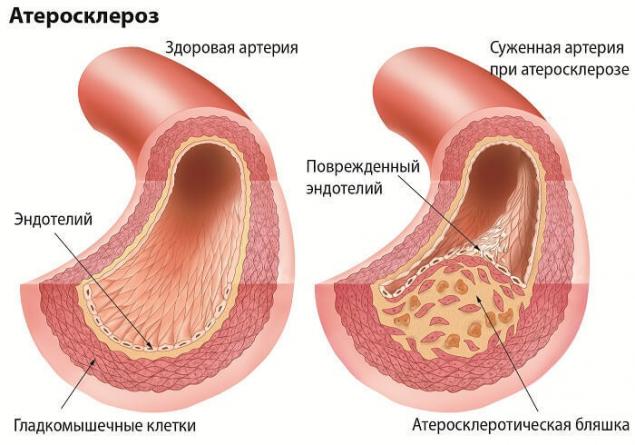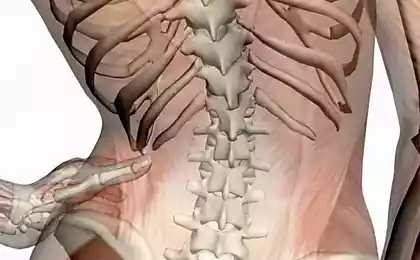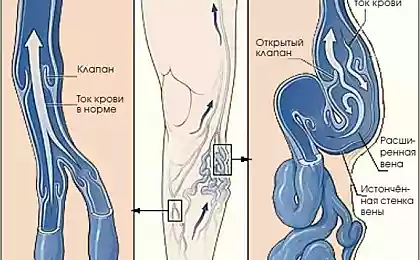479
Atherosclerosis of the vessels of the legs: alarming symptoms
Atherosclerosis of the legs is a chronic disease, the most common symptom of which are painful muscle cramps in the thighs or calves of the legs when walking, climbing stairs or during physical exercise.
The pain often goes away when you stop the exercise, though not immediately ─ it can take several minutes. Working muscles need more blood carrying oxygen than vacationers, but the transition from work to leisure, it takes some time.

The cause of this disease is the blockage of blood flow in the arteries due to the accumulation of plaque on their inner walls, causing the muscles not getting enough blood during exercise to meet the demand for oxygen and nutrients. Spasmodic pain in atherosclerosis of the vessels of the legs (called "intermittent claudication" or the syndrome of Charcot), is a method that uses the muscular system to warn you that she's not getting enough blood while increasing physical activity.
Many people with this chronic disease have no symptoms or mistake them for symptoms of other disorders. In fact, the cause of the pain in different places of the foot during exercise can be a blockage of blood flow in these places (see picture).

The blockage of blood flow in different parts of the legs atherosclerosis
iliac artery – iliac artery; femoral artery – femoral artery; popliteal artery – popliteal artery; tibial arteries – anterior tibial artery
The symptoms of severe atherosclerosis of the legs include:
Many people misunderstand the leg pain as a normal sign of aging. They may think it's arthritis, sciatica or just stiffness in the joints that occurs with aging. For an accurate diagnosis you need to know the source of your pain. If you have atherosclerosis of the legs, the source of the pain is in the muscles, not the joints.
People with diabetes may have the atherosclerosis of vessels of the legs with diabetic neuropathy, which is a common symptom of diabetes and is manifested in the form of a burning sensation or painful discomfort in the feet or thighs.
If you have any recurring pain, talk to your doctor and describe to him your condition as accurately as possible. If you have at least one of the risk factors for atherosclerosis of the feet you should clearly ask the doctor about this disease, even if you have no relevant symptoms.
Diagnosis of atherosclerosis of vessels of the legs
Diagnosis is based on the results of the physical examination of the patient, which may include the following:
How to cure an inflammation of the sinuses WITHOUT drugs
9 exercises from Oriental medicine to relieve pain in the neck
As noted above, atherosclerosis of the feet often has no symptoms. Undiagnosed and untreated, this disease can be dangerous, as can lead to very painful symptoms or loss of legs. In addition, these patients have an increased risk of coronary heart disease, stroke and heart attack, so the American heart Association encourages them more likely to visit a doctor to ensure early diagnosis and treatment of all the above diseases. published
Translation: Valentin Davituliani
Source: budzdorovstarina.ru/archives/3430
The pain often goes away when you stop the exercise, though not immediately ─ it can take several minutes. Working muscles need more blood carrying oxygen than vacationers, but the transition from work to leisure, it takes some time.

The cause of this disease is the blockage of blood flow in the arteries due to the accumulation of plaque on their inner walls, causing the muscles not getting enough blood during exercise to meet the demand for oxygen and nutrients. Spasmodic pain in atherosclerosis of the vessels of the legs (called "intermittent claudication" or the syndrome of Charcot), is a method that uses the muscular system to warn you that she's not getting enough blood while increasing physical activity.
Many people with this chronic disease have no symptoms or mistake them for symptoms of other disorders. In fact, the cause of the pain in different places of the foot during exercise can be a blockage of blood flow in these places (see picture).

The blockage of blood flow in different parts of the legs atherosclerosis
iliac artery – iliac artery; femoral artery – femoral artery; popliteal artery – popliteal artery; tibial arteries – anterior tibial artery
The symptoms of severe atherosclerosis of the legs include:
- Leg pain that does not go away when you stop training
- Wounds on the foot or toes that do not heal or heal very slowly
- Gangrene of the foot
- A noticeable decrease in temperature of lower leg or foot, especially compared to the other leg or the rest of the body
Many people misunderstand the leg pain as a normal sign of aging. They may think it's arthritis, sciatica or just stiffness in the joints that occurs with aging. For an accurate diagnosis you need to know the source of your pain. If you have atherosclerosis of the legs, the source of the pain is in the muscles, not the joints.
People with diabetes may have the atherosclerosis of vessels of the legs with diabetic neuropathy, which is a common symptom of diabetes and is manifested in the form of a burning sensation or painful discomfort in the feet or thighs.
If you have any recurring pain, talk to your doctor and describe to him your condition as accurately as possible. If you have at least one of the risk factors for atherosclerosis of the feet you should clearly ask the doctor about this disease, even if you have no relevant symptoms.
Diagnosis of atherosclerosis of vessels of the legs
Diagnosis is based on the results of the physical examination of the patient, which may include the following:
- Ankle brachial index ABI (method of examination of the patency of the blood vessels) ─ painless test in which blood pressure in the legs compared with the blood pressure in the hands, allowing you to determine how well the blood flows in the legs. This inexpensive test takes only a few minutes and can be performed by the attending physician as part of a normal medical examination. Normal blood pressure in the ankle by not less than 90 percent of the blood pressure in the hand, but in atherosclerosis it can be less than 50 percent.
- If the dimension of LPI found an abnormal ratio between the blood pressure values in the ankle and arm, you may need additional testing. Your doctor may recommend one of the following tests.
- Duplex ultrasound scanning: a non-invasive method that visualizes the artery with sound waves and measures the blood flow in the arteries, which allows you to see the availability of the lock vessel.
- Computed tomography angiography (CT scan): a noninvasive test that can show the arteries in the abdomen, pelvis and legs. This test is especially useful for patients with pacemakers or stents.
- Magnetic resonance angiography (MRA): a noninvasive test that gives information similar to a CT without using x-rays.
- Angiography: usually used in combination with the procedures for the treatment of vessels. During angiography in the artery, injection of contrast medium, and then fed x-rays to show blood flow in leg arteries and to identify any locks that may be present.
How to cure an inflammation of the sinuses WITHOUT drugs
9 exercises from Oriental medicine to relieve pain in the neck
As noted above, atherosclerosis of the feet often has no symptoms. Undiagnosed and untreated, this disease can be dangerous, as can lead to very painful symptoms or loss of legs. In addition, these patients have an increased risk of coronary heart disease, stroke and heart attack, so the American heart Association encourages them more likely to visit a doctor to ensure early diagnosis and treatment of all the above diseases. published
Translation: Valentin Davituliani
Source: budzdorovstarina.ru/archives/3430























